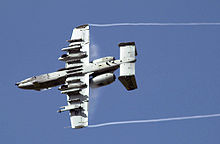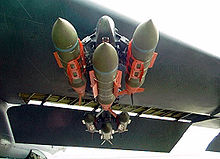External load station

An external load station ( English hardpoint ) is a device on an aircraft , generally an aircraft or helicopter , which allows a payload to be fixed outside the hull so that they can be transported during the flight safely.
While in rare cases the load is transported on the aircraft (for example Space Shuttle on the Shuttle Carrier Aircraft or SEPECAT Jaguar ), in most cases the external load stations are mounted under the wings or the fuselage.
If, in addition to the actual bracket, the external load station also has a clad carrier that ensures a certain distance between the wing and the load, this is called a pylon . Especially jet engines of modern aircraft are usually attached to pylons, the engine pylons .
In civilian use, mainly fuel tanks or an observation device such as radar or cameras are attached to external load stations.
In military use, in addition to the drop tanks and the sensors, it is mainly the weapon load that is attached to outstations.
Such external loads are activated and controlled electrically. The connection is established by connector systems. External load stations can be equipped with a pyrotechnic mechanism, which responds at the moment the external load is released (e.g. bombs or empty / full fuel tanks) (for example via a pyro ram) and thereby "shoots" the external load vertically downwards from the external load station (defined forced disconnection the external load).
Some modern combat aircraft have internal weapon bays that eliminate the disadvantages of external load stations (increased air resistance and radar cross-section ).
